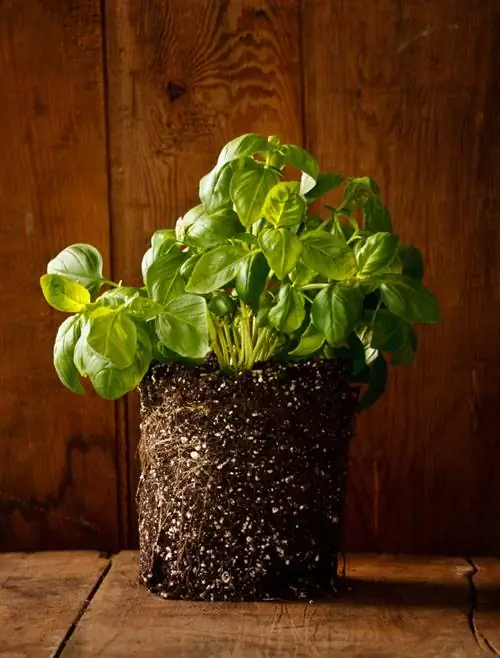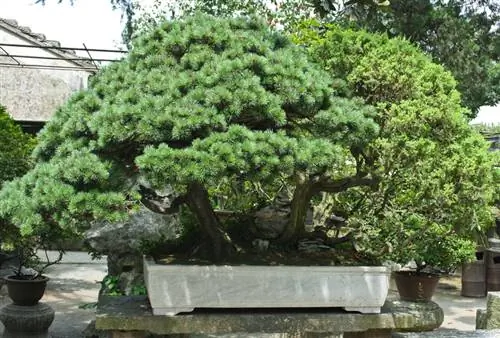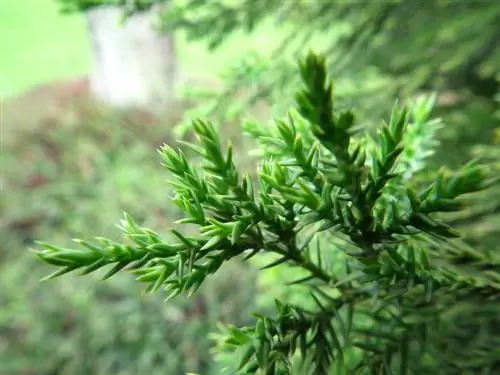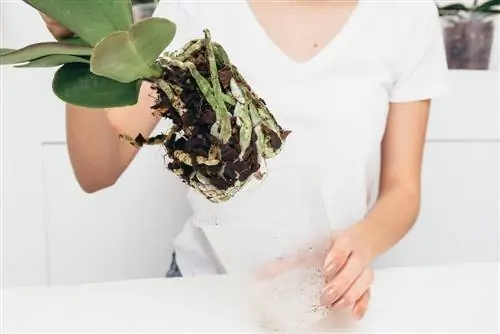- Author admin [email protected].
- Public 2023-12-16 16:46.
- Last modified 2025-06-01 06:02.
Read a commented profile about the sickle fir here. Compact information about growth and winter hardiness. Lots of tips on buying, planting and caring for Cryptomeria.
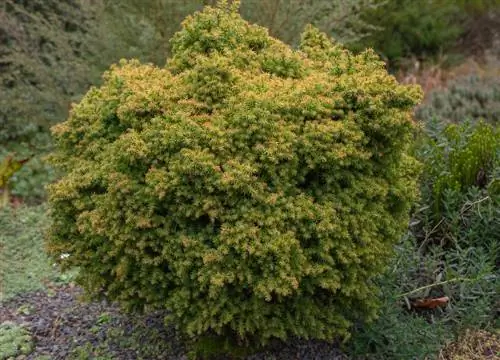
What characterizes the sickle fir?
The sickle fir (Cryptomeria japonica) is a hardy, evergreen conifer with sickle-shaped needles. It grows pyramid-shaped, reaches a height of 10 to 20 meters in Central Europe and prefers acidic, nutrient-poor soils. The conifer requires little care, but depends on a consistent water supply.
Profile
- Scientific name: Cryptomeria japonica
- Family: Cypress family (Cupressaceae)
- Origin: Japan, South China
- Synonyms: Japanese cedar, sugi, Japanese sickle fir
- Growth type: Conifer
- Growth height: 10 m to 20 m
- Leaves: Needles
- Leaf characteristics: sickle-shaped, evergreen
- Flowers: Cones
- Fruits: cones
- Bark: red-brown, dark brown
- Winter hardiness: hardy
Growth
The sickle fir is one of the most beautiful conifers for creative garden design. In its Japanese homeland, the conifer is an important forest tree. Its light, fragrant wood is sought after for building bridges and artistic furniture. The following key growth data illustrate the magical charisma of a picturesque natural beauty from the land of smiles:
- Growth type: single-stemmed conifer
- Crown: slender-pyramidal, increasingly broad-conical with age, densely branched, young branches slightly drooping.
- Growth height: in Central Europe 10 m to 20 m, in Asia up to 60 m.
- Growth width: in Central Europe 4.5 m to 7 m, in Asia up to 20 m.
- Annual growth: 50 cm to 80 cm
When young, the thick, soft bark sets decorative accents with a subtle, reddish color. As it ages, the bark turns dark brown and peels off in long strips. Bright reddish-brown trunk wood appears underneath.
Video: Japanese sickle fir - planted in 1865 in Fürstenlager State Park
leaves
The German name sickle fir is borrowed from the shapely leaves with these specific properties:
- Leaf shape: crescent-shaped needles, tapering to a point
- Leaf size: 6 mm to 15 mm, rarely up to 30 mm long
- Leaf color: dark green
- leaf phase: evergreen
- Winter coloring: dark brown to bronze colored
- Texture: hard
- Arrangement: spiral, close-fitting
The evergreen needles are replaced at intervals of four to five years. During this inconspicuous process, a Japanese sickle-fir sheds isolated needles or shoots in stages.
Flowers
The sickle fir thrives as a monoecious, separate-sex conifer. Male and female flowers sit on a tree, recognizable by these features:
- Male flowers: long-elliptical, green, later yellowish-orange, standing in the leaf axils of the needles.
- Female flowers: spherical, 2 cm in diameter, inclined at the end of short shoots.
- Flowering time: in Central Europe from March to April
Mannbar is a Japanese cedar usually over 20 years old. Varieties refined in Central Europe bloom significantly earlier.
Fruits
Pollinated female flowers undergo a striking transformation. Within a short time, the small flower balls grow into brown cones about 3 centimeters long. At the same time, the scaled cones turn 180° upwards. From October onwards, the ripe, brown fruits stand upright on curved stems, like we know from local pine cones.
Winter hardiness
A well-rooted Sugi is frost-resistant down to -35° Celsius. Young sickle firs have to develop this stable winter hardiness in the first few years. Read the care instructions to find out how to help Asian conifers with simple winter protection.
Planting sickle fir
For an Asian garden idyll in beds and pots, you can buy ornamental and small sickle firs from the tree nursery. The best time to plant is in spring. This means that the frost-sensitive young trees have enough time to establish resilient roots until the first frost. Read the best tips about purchasing, location and planting here:
Buy sickle fir
Hobby gardeners prefer to plant a garden-suitable Sugi variety because the original species, with a height of up to 20 meters, is far too large for beds, terraces or balconies. The following table names five popular sickle fir varieties that you can buy at the tree nursery:
| Variety | Botanical name | Growth height | Speciality | Price |
|---|---|---|---|---|
| Hahnenkamm sickle fir | Cryptomeria japonica Cristata | 6-8 m | shoots grown together to form a cockscomb | from 34.95 EUR (50-60 cm in the container) |
| Elegant sickle fir | Cryptomeria japonica Elegans Viridis | 4-6 m | cone-shaped, bluish-green needles | from 45, 70 EUR (60-80 cm in the container) |
| Small sickle fir | Cryptomeria japonica Globosa Nana | 0, 5-0, 8 m | ball-crowned stem | from 157, 29 EUR (80 cm trunk height) |
| Dwarf sickle fir | Cryptomeria japonica Little Champion | 0, 3-0, 8 m | half-round shrub with fresh green needles | from 16.99 EUR (15-25 cm in container) |
| Sickling fir things | Cryptomeria japonica Dinger | 1, 0-1, 5 m | compact, wide-pyramidal silhouette | from 140 EUR (50-60 cm in a pot) |
The majestic pure Cryptomeria species is perfect for the large Japanese garden or the individual position in the extensive park. For a young Sugi conifer in a pot with a height of 30 centimeters you pay from 9.99 euros at the tree nursery. Because the sickle fir is one of the growth rockets among coniferous trees, an impressive size is achieved within just a few years.
Location
The sickle fir thrives best when the air is saturated with water vapor and the soil is on a par with good forest soil. The location should be like this:
- Sunny, shaded to partially shaded.
- Ideally protected from the wind and humid near a pond, stream or pool.
- Deep, fresh to moist loamy soil, preferably sandy and permeable.
- Important: acidic pH value, low in lime, low in nutrients.
Planting
Good soil preparation, avoiding initial fertilization and protection from wind are the focus of expert Sugi planting. The following tips briefly and concisely explain how to plant a sickle fir correctly:
- Test the pH before planting.
- If the pH value is greater than 5, mix the excavated planting pit with rhododendron soil.
- Place the root ball in a tub of rainwater until no more air bubbles appear.
- Planting a sickle fir with a support post to prevent wind throw (connect the trunk and post with soft hose ties).
- Water abundantly and regularly on the day of planting and afterwards.
Please ensure there is sufficient planting distance from trees, buildings and the property line. The Japanese sickle fir is best planted in a single position.
Excursus
Jomon-Sugi - Methuselah of the sickle trees
The oldest sickle fir in the world can be admired on the Japanese island of Yakushima. Scientists estimate the age of Jomon-Sugi to be a biblical 2,400 to 7,200 years old. Hundreds of years ago, the Sugi Methuselah escaped the axes of zealous woodcutters only because it grew so irregularly. Other famous trees line the path to the location at an altitude of 1292 meters, such as the 'Great King Cedar' (Daio-Sugi). In 1993 the magical forest was declared a World Heritage Site by UNESCO.
Care for sickle fir
Like most conifers, the sickle fir is very easy to care for. The mainstay of the care program is the consistent water supply. A cut back cannot significantly embellish the representative silhouette. Frost-sensitive young plants are grateful for light winter protection. You can read important information about skilful Sugi care here:
Pouring
Proper watering supports deep rooting in shallow-rooted coniferous trees, such as the sickle fir. The water quality contributes significantly to he althy, magnificent growth. This is how you water a Japanese cedar in an exemplary manner:
- Water thoroughly when dry.
- Let the soil dry to the touch until the next watering.
- Use predominantly rainwater or pond water as irrigation water.
By mulching the tree disc or planting it with low heather plants, the soil stays moist and weed-free for longer.
Fertilize
The sickle fir is not fertilized. A supplementary supply of nutrients delays the ripening of the young shoots before winter. The negative consequence is a significant impairment of winter hardiness.
Cutting
Regular pruning is not part of the care program. Like all conifers, the sickle fir resents a cut into the old wood and stops growing at this point. You can shorten overly long branches that protrude out of shape, as long as the cutting is limited to the green needled area.
Pruning is recommended for conifers every three to four years. The best time is the end of February/beginning of March. Cut off dead branches on Astring. Unfavorably positioned, damaged or diseased shoots can be directed to a promising side branch.
Wintering
Winter protection in the first few years, precautions against snow pressure and watering in the event of frost are the most important key data for correct winter care. It's worth taking a look at these tips:
- Winter protection: Cover the tree disc with leaves and brushwood, cover the crown with fleece.
- Snow pressure prevention: in snowy regions, loosely tie branches together with string.
- Winter care: If it is dry, water in winter on mild days.
Sickle firs in pots are susceptible to frost damage. Wrap the pot thickly with fleece or bubble wrap and slide a wooden block underneath. It makes sense to change location to the shady, wind-protected house wall.
Popular varieties
Beyond the sickle fir favorites mentioned above, there are these beautiful varieties to discover in the nursery:
- Little Diamond: elegant stem with a spherical crown, light green needles turn reddish in winter.
- Vilmoriniana: distinctive dwarf sickle fir for beds and pots, bushy-hemispherical, 50 cm high, 100 cm wide.
- Lawn sugi: boasts of bizarre twisted branches, dark green needles, columnar shape, 10-15 m high, 4-6 m wide.
FAQ
My sickle fir turns brown in winter. What to do?
It is completely normal for the needles of a sickle fir to turn brown in winter. After the cold season, the needles take on a fresh green to dark green color again.
Does the sickle fir grow thicker after pruning?
Basically, you don't necessarily have to cut a sickle fir. However, the Asian conifer actually grows denser and more compact after pruning. To do this, shorten the shoots in the green needled area by a few centimeters. Because Cryptomeria japonica are sensitive to frost when young, as a precaution, prune after the last winter frosts and before budding begins.
Can I plant a sickle fir in low mountain ranges at 600 m?
The sickle fir is native to Japan and southern China, where it is used as a forestry tree. In the first few years, the coniferous tree is at risk of frost. Only an older specimen in Central Europe has sufficient winter hardiness. The Japanese cedar loves high humidity, but cannot tolerate strong winds and is susceptible to snow breakage. The conifer does not mature well on nutrient-rich soils and is sensitive to frost even when it is older. Against this background, planting at high altitudes in the low mountain ranges is not recommended.



